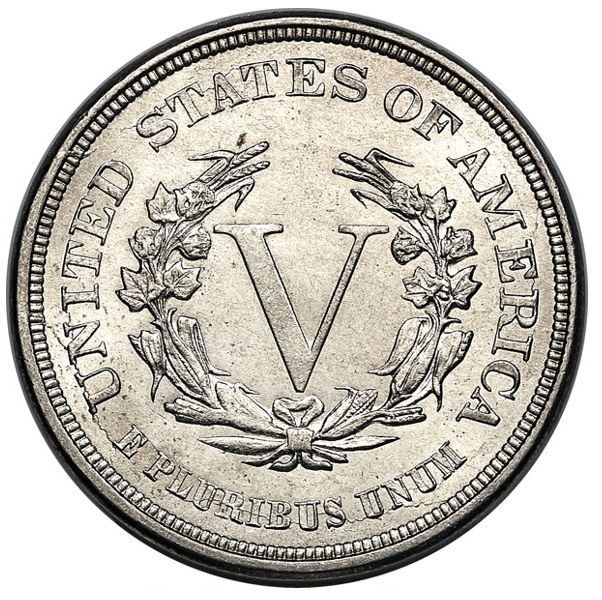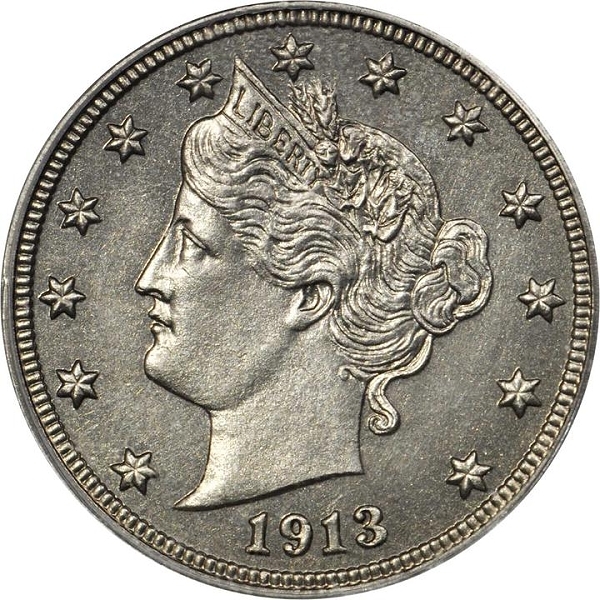By Dan Duncan – Retired, Pinnacle Rarities ……
The Liberty nickel, also referred to as the “V” nickel, is a simple design by Charles E. Barber featuring Liberty’s head on the obverse and a Roman numeral V on the reverse within a wreath. They were struck in copper-nickel, the same alloy being used already in the three-cent piece and the Shield nickel at the time. Production began in 1883 and finished in 1912. There were only two branch mint issues and two varieties in the initial year 1883, leading to 33 coins needed to complete a set of the business strikes. Proofs were issued in each year and with the two 1883 varieties, 31 coins complete that set, unless you are one of three lucky individuals in possession of a 1913 Proof.
 Initially, it had not been thought necessary to inscribe the word “cents” on the nickel, as the silver and copper-nickel three-cent pieces had circulated for years with only a simple Roman numeral indicating their denominations. Unfortunately, fraudsters soon were gold plating and passing them off for $5 gold coins, which were of a similar diameter. As the Liberty nickel design was new, they were accepted as gold by some unsuspecting merchants at 100 times their actual value. Outraged Mint officials brought production to a sudden stop and Barber quickly prepared a new design with CENTS in big, bold letters below the V. Five-and-a-half million of the “No CENTS” nickels, however, were already in circulation; even today it isn’t uncommon to locate these “racketeer nickels” in hoards and collections.
Initially, it had not been thought necessary to inscribe the word “cents” on the nickel, as the silver and copper-nickel three-cent pieces had circulated for years with only a simple Roman numeral indicating their denominations. Unfortunately, fraudsters soon were gold plating and passing them off for $5 gold coins, which were of a similar diameter. As the Liberty nickel design was new, they were accepted as gold by some unsuspecting merchants at 100 times their actual value. Outraged Mint officials brought production to a sudden stop and Barber quickly prepared a new design with CENTS in big, bold letters below the V. Five-and-a-half million of the “No CENTS” nickels, however, were already in circulation; even today it isn’t uncommon to locate these “racketeer nickels” in hoards and collections.
No significant further changes were made in the Liberty nickel’s simple, straightforward design. Philadelphia produced the entire mintage except in 1912 when Denver and San Francisco struck the coins as well. Although it covers 30 years, the Liberty nickel series is a compact and relatively easy to complete set, largely because of this near-total lack of branch mint issues. The low-mintage issues–1885, 1886, and 1912-S—are scarce, but there are no great rarities. The 1912-S at 238,000 coins is the only issue with a mintage below a million. At the other extreme, no date exceeded 40 million. The 1911 is the highest with just over 39.5 million.
Proofs were made every year and always in the thousands – a high level for Proofs in that period. There is dramatic variability, however, in their quality over the 30 years of production. Their quality steadily declined from 1883 through 1889, with the years 1886-1889 being the worst. Many Proof Liberty nickels from this period are difficult to distinguish from their business strike counterparts. Manufacturing improved beginning in 1900, and excellent pieces, like those often found from 1883, are more readily available from 1903 through 1909.
The Proofs of 1910 to 1912 are less consistent, but exceptional pieces can be located. Several Proof dates can be surprisingly challenging in the top grades, especially in Cameo conditions, with 1889 being the most difficult date to locate with a Cameo designation. A very few Deep Cameos exist as well, but only for roughly half of the dates in the series.
In late 1912, the decision was made to replace the Liberty Head design with James Earle Fraser’s Buffalo/Native American design beginning in 1913. No Liberty nickels were made officially in 1913, but one or two Philadelphia Mint employees collaborated to strike at least five 1913s before those dies were destroyed.
These were first revealed to the numismatic community in 1919 when an advertisement seeking such coins was placed as a cover story to account for their existence by Samuel W. Brown (the ad offered $500 cash for one). All five soon ended up in the collection of the famous Fort Worth collector Col. E.H.R. Green. Six years after Green’s death in 1936, the five were dispersed to various new owners and their provenances have continued to grow. Two are currently on public display at the Smithsonian Institution in Washington, D.C. and the ANA Money Museum in Colorado Springs, while three are owned privately. The Eliasberg specimen, widely considered the highest quality of the five, became the first United States coin to sell for over a million dollars in 1996 ($1,485,000 USD). It last traded publicly in 2018 in a PCGS PR66 holder, where it crossed the auction block for $4.56 million.
 Despite their suspicious origins, these 1913 Proofs are accepted as legitimate and rank among the most coveted and valuable of all U.S. coins.
Despite their suspicious origins, these 1913 Proofs are accepted as legitimate and rank among the most coveted and valuable of all U.S. coins.
Controversy marked both the beginning and end of the Liberty Head nickel, a fact that may be unique in all American numismatics. Although it spans 30 years, the lack of all but two branch mint issues and no uber-rare dates make it a popularly collected series. Besides the notorious 1913, the Proof run is also relatively easy to assemble, although Cameos and Deep Cameos are elusive or nonexistent for some dates. We have always loved this series and currently have an exceptional selection available, including the three Key dates.





I have a 1893 V nickel, not in mint or close to mint…..is it worth anything?
I have a 1912 V nickel is it worth anything?
I also have a V nickel 1887&1889.. Just trying to find out if they are worth anything!
I have a 1912d liberty nickel 10% off struck error coin. It’s extremely rare.